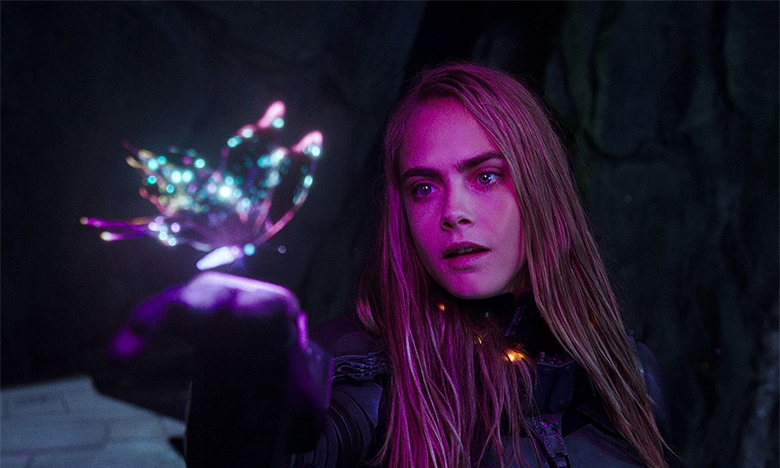The inspiration for this summer’s sci-fi blockbuster, Valerian and the City of a Thousand Planets, goes back to a graphic novel from director Luc Besson’s childhood. The 58-year-old wanted to turn Valerian and Laureline, originally published in 1967, into a film as early as when he was directing the much-lauded film The Fifth Element. The seminal graphic novel is also rumored to have influenced George Lucas’ Star Wars.
Here’s the premise: Set in the 28th century, Valerian (Dane DeHaan) and Laureline (Cara Delevingne) are special operatives tasked with maintaining order in human territories. The city of Alpha, where the duo’s mission takes place, teems with thousands of species, including some deemed foreign — like shape-shifting stripper Bubble, played by singer Rihanna. Within scenes of terrestrial abundance and intergalactic imagination, Besson touches on numerous social issues in a future world full of difference.
WHAT WAS IT LIKE ADAPTING A GRAPHIC NOVEL INTO A FILM?
Luc Besson: It’s like you have to make dinner for your friends, and you open the fridge, and it’s full. That’s what it’s like to use a graphic novel; it doesn’t make the story, but at least your fridge is full. Because there are 29 albums of Valerian full of aliens, monsters, story, themes, souls — it’s full. When you’re building your own story, you’re using what you want in it, and that’s why it’s more practical. If you don’t start with a novel or a comic book, then you start really from ground zero. You have to start by going to the market and buying the food.
WHAT WAS AN UNEXPECTED CHALLENGE WHEN ADAPTING THE GRAPHIC NOVEL?
Well, to adapt was not the challenge. The real challenge was the soul and the rhythm of the film. The two hours that you have a certain music for is diluted over five years [of making the film]. So to be sure that you have the same emotion, the same pattern, the same soul — that it’s unified — it’s very, very complicated because you have five years to get lost. The process was so long. I was scared that the film would start very slow and finish very fast. Or the character would look sad at the beginning and happy at the middle. It is very complicated, and it needs you to concentrate every morning and have some tricks to remember where you were the day before. It’s almost like playing chess and remembering every move since the beginning.
"LET ME TELL YOU THAT TOMORROW IF THERE ARE ALIENS COMING, WE FEEL ALL LIKE BROTHERS. AND THAT’S THE MESSAGE OF THE FILM."
DID YOU HAVE ANY SOURCE MATERIAL OUTSIDE THE GRAPHIC NOVEL THAT INFLUENCED THE FILM?
Besson: No, but I worked with graphic people … and they were very, very creative. And sometimes they came with a drawing or an alien that amazed me, and I would modify the script a little bit because it provoked so much to see the drawing that it was worth it to adapt the script to get this thing in; it makes it richer. The first time I saw the drawing of Da — the little boy in the toy shop — suddenly it defined the way the shop looks, and suddenly the shop became very, very colorful because Da was very colorful. We didn’t work on the shop until we had Da. The mother of Da didn’t exist in the script, and then because of Da I got the idea of having the mother exactly the same but bigger, and then to have the jokes: “Go to see Mommy,” and “Mommy is coming.” That’s the kind of [collaboration] between the script and the creators of the film.
WERE THERE ANY CHARACTERS THAT YOU COULDN’T INCLUDE FROM THE GRAPHIC NOVEL?
Besson: I included the ones I love the most, which are the Doghan Daguis (the three stooges), the jellyfish, the big monsters, the pirate, the pearls, the commander, the city of Alpha (the city of 1,000 planets). I took all the elements that I love from the comic and I put them in.
HOW DO THEMES OF BEING AN OUTSIDER IN SOCIETY AND “OTHERNESS” PLAY INTO THE FILM?
Besson: Bubble [Rihanna’s character] is an immigrant. All the aliens in Alpha, they are all different. It’s kind of a positive vision of the future that no matter our differences, we can live together. They succeed in the 28th century what we couldn’t do now. Well, rarely we can do it. We have so many differences that stop us from coexisting today. Colors, race, religion — let me tell you that tomorrow if there are aliens coming, we feel all like brothers. And that’s the message of the film. I swear to you as soon as we discover that there is someone else, we’re going to feel like brothers. We see all these aliens coming in, and we’re shaking hands and we have to be unified; we’re all brothers, believe me. It’s a funny way of saying a very important message.
Valerian and the City of a Thousand Planets opens in theaters on July 21.

